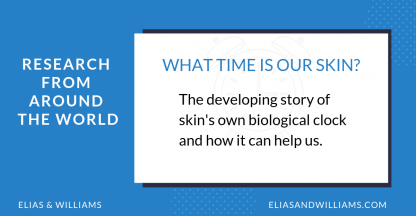Welcome to the Professionals' Section of EliasAndWilliams.com.
We wanted to provide all professionals who deal with the skin and its disorders with additional information and resources. Here, we offer commentary on some of the latest research coming from our laboratories at the University of California San Francisco and from other leading laboratories around the world. We also offer a free, illustrated booklet, Primer on the Skin Barrier, that provides the key elements of rational, science-based skin care. We welcome your comments and suggestions.
SPECIAL SERIES: Reports from the International Investigative Dermatology meeting in Orlando, May 2018
In a series of posts to follow, we will present new information on the skin barrier and related topics, which were presented at the recent IID meeting in Orlando. Some of these posts will concern new work from the Elias laboratory, while others will report discoveries from other laboratories around the world.
The IID is a combined meeting every five years of the Society for Investigative Dermatology, an American society, as well as the European Society for Dermatologic Research and the Japanese Society for Investigative Dermatology.Research: From The Elias Lab

Top 5 Scientific Discoveries About Skin Of The Decade
By Peter M. Elias, M.D. & Mary L. Williams, M.D.
We have learned a lot about skin and its permeability barrier in recent years. Here are our picks for the top 5 discoveries about skin of the past decade. Some of these arose from work in our laboratory, and some from research by other investigators. 1. Common inflammatory skin diseases, like the eczemas and even psoriasis, begin with an inherited weakness in the skin’s barrier. This revelation came pretty much as a surprise to everyone in the dermatologic research … [Read More...]

The How and Why of Sensitive Skin
An alarming percentage (about 60%) of normal adults, mostly women, self-report that they regularly experience ‘sensitive skin’. Most perceive ‘sensitive skin’ as various amounts of stinging, burning, irritation, and itch with the use of skin care products. In a large population based study in China, we found no increase in the proportion of females among those patients whose reactions were severe enough to seek the help of a dermatologist, but we did find the reactions to be more marked in older … [Read More...]

2018 IID Meeting Update: Deciphering The Link Between Atopic Dermatitis and Autism
There seems to be little doubt that both autism and atopic dermatitis have become much more prevalent in recent years. In neither disorder is the cause nor the reason for the current epidemics entirely understood. We have addressed the hypotheses concerning the atopic dermatitis epidemic elsewhere on this site. Recently, several population-based studies have demonstrated an increased incidence of autism spectrum disorders in children with atopic disorders, including atopic … [Read More...]
Research: From Labs Around the World

Top 5 Scientific Discoveries About Skin Of The Decade
By Peter M. Elias, M.D. & Mary L. Williams, M.D.
We have learned a lot about skin and its permeability barrier in recent years. Here are our picks for the top 5 discoveries about skin of the past decade. Some of these arose from work in our laboratory, and some from research by other investigators. 1. Common inflammatory skin diseases, like the eczemas and even psoriasis, begin with an inherited weakness in the skin’s barrier. This revelation came pretty much as a surprise to everyone in the dermatologic research … [Read More...]

Sunscreens In The Blood?
Matta et al have now shown what we all should have seen coming: the chemicals of our most common and effective sunscreens do not just sit on the skin’s surface and soak up damaging ultraviolet rays before these rays can penetrate to deeper layers and injure nuclear DNA. No – these chemicals themselves can penetrate the skin’s barrier and enter the blood stream (and from whence they can theoretically go anywhere in the body). We should have seen this coming because: a) the permeability barrier is … [Read More...]

What Time Is Your Skin?
Body Time As the Earth’s rotation creates alternating hours of light and dark, we adapt our behaviors to harmonize with this daily cycle. An internal ‘clock’ adjusts our metabolism to fit the demands of our usual daytime and nighttime activities. This makes good sense, since our metabolic needs are very different when we are sleeping and fasting, in comparison to what we need when awake, working and eating. Until recently, it was believed that this biological clock resided solely in the brain … [Read More...]